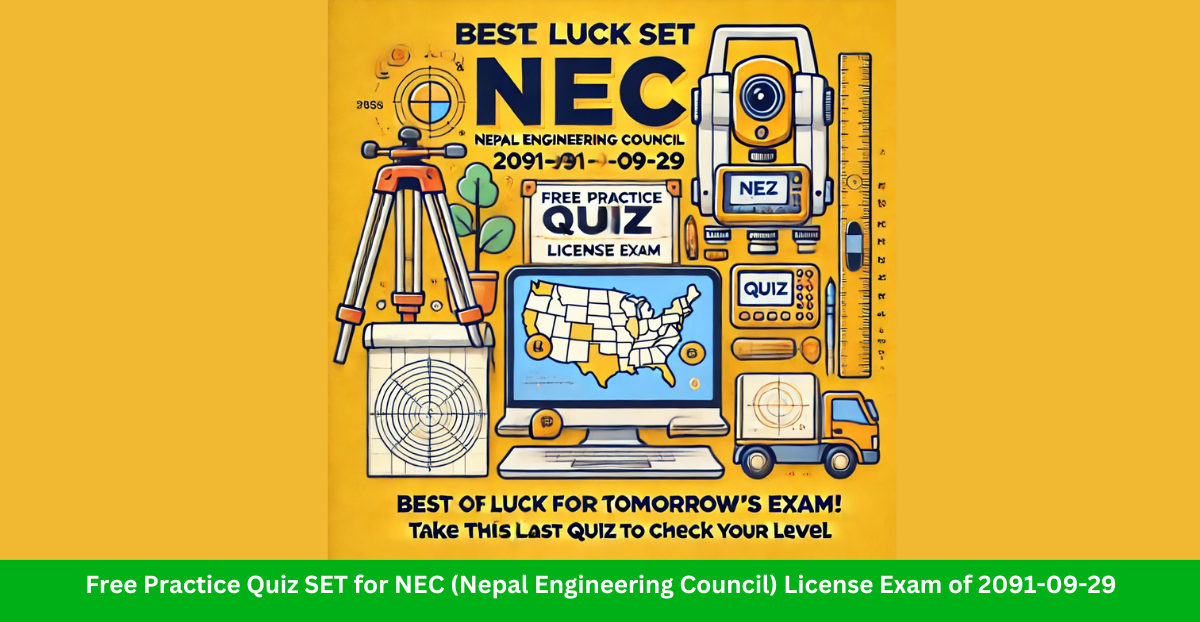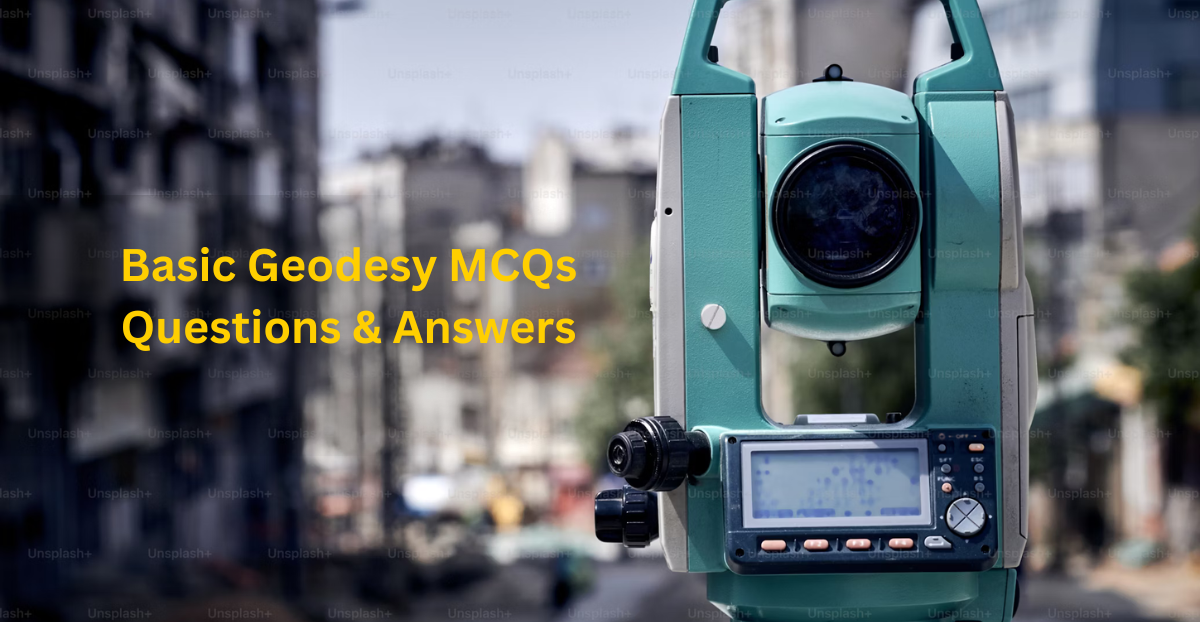1. What is the fundamental purpose of geodesy? A) To calculate weather patterns and climate changes. B) To manage and preserve Earth’s natural resources. C) To accurately measure and understand Earth’s geometric shape, orientation, and gravity field. D) To estimate geological activity and earthquake risks. View Answer C) To accurately measure and understand Earth’s geometric shape, orientation, and gravity field. 2. How do modern geodesists primarily determine the coordinates of points on the Earth’s surface? A) Applying Earth-based surveying tools with lasers. B) Using space-based tools such as the Global Positioning System. C) Utilizing aerial photogrammetry from high-flying aircraft. D) Employing marine navigation techniques across oceans. View Answer B) Using space-based tools such as the Global Positioning System. 3. Why is the ellipsoid used as a basic model in geodesy? A) It precisely models all mountains and valleys. B) It mimics the exact topography of the Earth’s surface. C) It reflects climate zones and vegetation accurately. D) It is simple, smooth, and captures the Earth’s largest features. View Answer D) It is simple, smooth, and captures the Earth’s largest features. 4. What allows different kinds of maps to be consistent with one another in geodesy? A) The incorporation of GPS technology in all maps. B) The application of uniform ellipsoid models globally. C) The National Spatial Reference System based on accurately measured points. D) The use of global mean sea levels for measurement. View Answer C) The National Spatial Reference System based on accurately measured points. 5. What is the main difference between an ellipsoid and a geoid in geodesy? A) A geoid varies greatly between continents, whereas an ellipsoid is universal. B) A geoid accounts for climate effects, while an ellipsoid does not. C) An ellipsoid changes with tides, while a geoid remains static. D) An ellipsoid is completely smooth, while a geoid mirrors global mean sea level. View Answer D) An ellipsoid is completely smooth, while a geoid mirrors global mean sea level. 6. Which of the following factors contributes to making Earth the densest terrestrial planet? A) The greater mass of Earth’s crust B) The presence of a liquid outer core surrounding a solid inner core C) A thicker mantle compared to other planets D) Earth’s larger equatorial diameter View Answer B) The presence of a liquid outer core surrounding a solid inner core 7. Why is Earth’s shape described as an oblate spheroid? A) The influence of gravity creates a perfect sphere B) Local variations cause substantial changes in measuring C) It contains significant topographical differences like Mount Everest D) Centrifugal force due to rotation causes a bulge at the equator View Answer D) Centrifugal force due to rotation causes a bulge at the equator 8. How did the early geodesist Eratosthenes contribute to the study of Earth’s size and shape? A) He developed the concept of the geoid B) He created the National Spatial Reference System C) He estimated Earth’s circumference to be close to the current value. D) He measured the equatorial bulge of Earth View Answer C) He estimated Earth’s circumference to be close to the current value. 9. What role do datums play in the science of geodesy? A) They are used to construct the theoretical ellipsoid model B) They account for Earth’s rotation and centrifugal force C) They determine local topographical differences D) They serve as reference points for global surveying and mapping. View Answer D) They serve as reference points for global surveying and mapping. Related Articles: Compass Surveying High Level MCQ Questions and Answers Fundamentals of Photogrammetry MCQ Questions & Answers Triangulation Surveying MCQ Questions and Answers 10. Which technological advancement has significantly improved the precision of geodesic measurements? A) Satellites and global positioning systems (GPS) B) The calculation of Earth’s average density C) Advancements in topographical modeling techniques D) Developments in estimating the equatorial bulge View Answer A) Satellites and global positioning systems (GPS) 11. Which key characteristic distinguishes the World Geodetic System of 1984 (WGS 84) from North American datums like NAD 27 and NAD 83? A) It uses terrestrial measurements only. B) WGS 84 was established before 1983. C) WGS 84 provides global coverage unlike the others. D) It is fixed at a point in Kansas. View Answer C) WGS 84 provides global coverage unlike the others. 12. What is the primary purpose of a datum in the context of GIS? A) It is used for determining altitude like sea level. B) It defines the climate patterns for a region. C) It provides a reference for calculating geographical coordinates. D) It calculates time zones for various areas. View Answer C) It provides a reference for calculating geographical coordinates. 13. What is a significant procedural recommendation when dealing with multiple datums in GIS data analysis? A) Preserve original datums for diversified analysis. B) Convert all data to a single datum before analysis. C) Convert datums after completing the analysis. D) Use at least three different datums concurrently. View Answer B) Convert all data to a single datum before analysis. 14. How was the North American datum of 1983 (NAD 83) primarily different in set-up from NAD 27? A) NAD 83 is fixed at a point in Kansas. B) NAD 83 focuses on European coordinates. C) NAD 83 uses fewer measurement points. D) NAD 83 uses an Earth-centered ellipsoid reference. View Answer D) NAD 83 uses an Earth-centered ellipsoid reference. 15. Why is it important to consider the updates in datums, particularly NAD 83 and WGS 84, in GIS? A) They undergo frequent updates impacting data accuracy. B) Updates only affect data within the equator. C) Updates make older data completely unusable. D) There are no changes in global coordinates. View Answer A) They undergo frequent updates impacting data accuracy. 16. What is the primary characteristic of the 3-D coordinate system when applied to Earth’s geography? A) It assumes Earth is a perfect flat plane. B) It ignores the curvature in short distances. C) It can only measure distances along the Equator. D) It accounts for Earth’s … Read more

